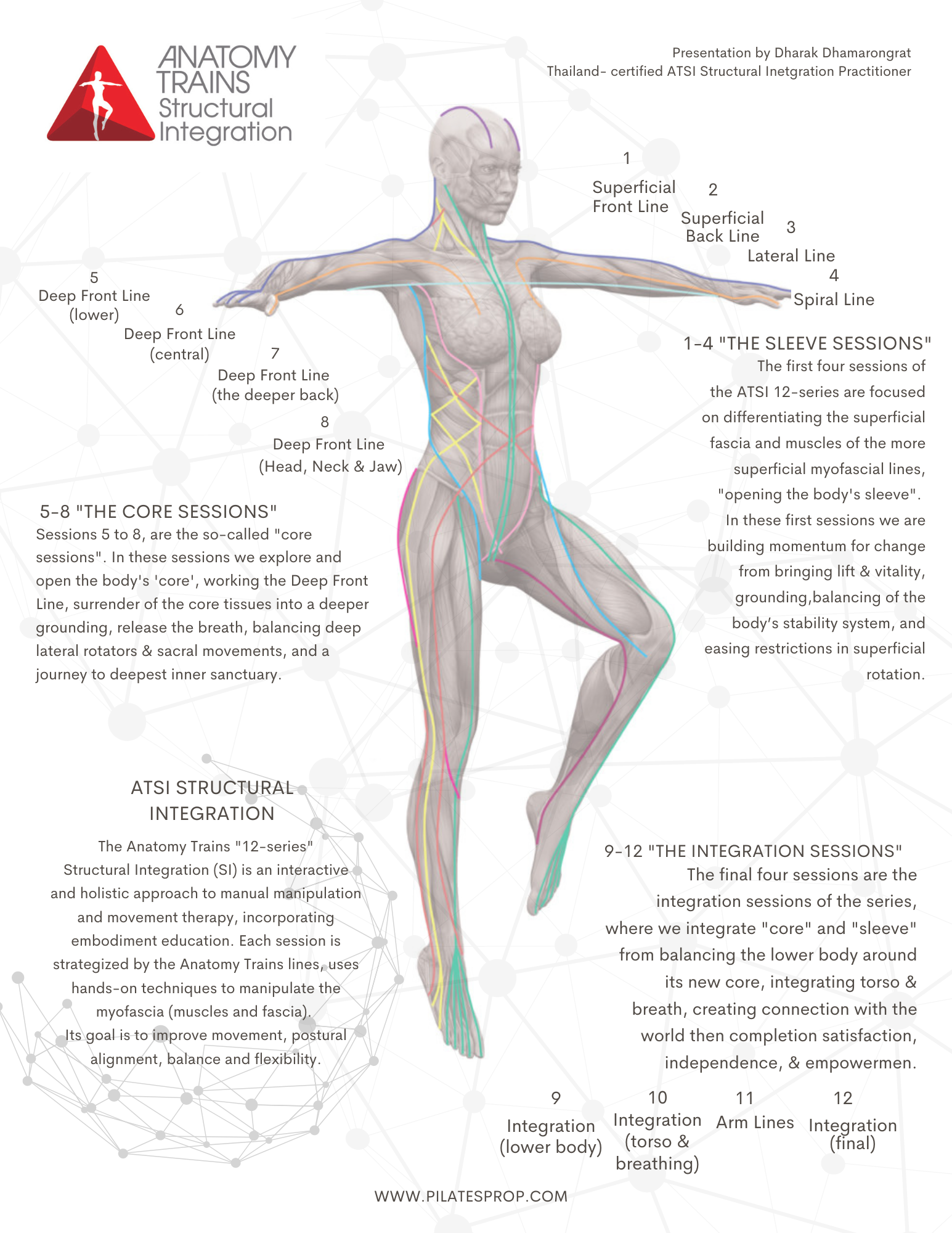
Anatomy Trains Structural Integration (ATSI)
"ศิลปะ วิทยาศาสตร์ และงานฝีมือ" ของการรักษาด้วยการสัมผัส โดยทอม ไมเยอร์ส
ATSI พัฒนาหลักการและเทคนิค myofascial จาก Rolfing ซึ่งเป็นรูปแบบดั้งเดิมของการจัดโครงสร้างที่สร้างขึ้นโดย Dr Ida Rolf ในปี 1970 Anatomy Trains Structural Integration พัฒนาทฤษฎีเกี่ยวกับเส้นเมอริเดียน myofascial ที่เรียกว่า Anatomy Trains ที่ค้นพบและเผยแพร่โดย Tom Myers
"แนวทาง Anatomy Trains SI คือการปลดปล่อยการผูกและการตัดทอนในเนื้อเยื่อเกี่ยวพันเหล่านี้ สิ่งที่เราเรียกว่าเครือข่ายพังผืด และเพื่อให้การศึกษาแก่ร่างกายในรูปแบบที่มีประสิทธิภาพและยั่งยืนพลังงาน"
แต่ละเซสชันจะมีการวางแผนการบำบัด ด้วยกลยุทธ์ตามหลักการของ Anatomy Trains มีการใช้เทคนิค hand-on เพื่อจัดการ myofascia (กล้ามเนื้อและพังผืด) เป้าหมายคือช่วยปรับปรุงการเคลื่อนไหว การจัดตําแหน่งท่าทาง ความสมดุล และความยืดหยุ่น
ด้วยเหตุนี้ จึงสามารถช่วยแก้ไขปัญหาเรื้อรังในระยะยาวได้อย่างยอดเยี่ยม เช่น ปวดหลัง ปวดคอและไหล่ ตลอดจนปรับปรุงนิสัยการทรงตัวที่ไม่ดี ช่วยส่งเสริมสรีระที่มีสมดุลที่จะช่วยให้คุณใช้ร่างการได้ถูกวิธีและมีคุณภาพชีวิตที่ดีขึ้นได้

Anatomy Trains Structural Integration คือหลักสูตรนักบำบัดจัดโครงสร้างด้วยทฤษฎี Myofascia 12 Meridians ของสถาบัน Anatomy Trains, USA
ATSI ใช้แผนที่ Anatomy Trains meridians เพื่อให้เหตุผลเชิงตรรกะสำหรับขั้นตอนการบำบัด SI 12 ซีรี่ส์
Anatomy Trains คือทฤษฎี Myofascia meridian แผนผังโครงสร้างของร่างกายที่อธิบายถึงการทำงานของแนวเส้นเอ็นพังผืดและกล้ามเนื้อที่ทำงานประสานกันที่มีทั้งหมด 12 เส้น ดังนี้
The superficial front line
The superficial back line
The lateral line
The spiral line
The deep front line
The superficial front arm lines
The deep front arm lines
The superficial back arm lines
The deep back arm lines
The front functional line
The back functional


"... SI พยายามที่จะจัดระเบียบร่างกายอย่างใกล้ชิดรอบเส้นแนวตั้งของแรงโน้มถ่วงและยืดมันไปตามเส้นนั้น"
-ทอม เมเยอร์ส
'สูตร' ของ ATSI สําหรับการรวมโครงสร้างมีพื้นฐานมาจากแนวคิด "Anatomy Trains Myofascial Meridians" ซึ่งอธิบายไว้ในหนังสือที่เขียนโดย Thomas Myers ตีพิมพ์โดย Harcourt Brace (Elsevier) ในปี 2544 และฉบับที่ 2 ในปี 2551
มี "3 Series" ซึ่งเป็นการแนะนําโครงสร้างตัวถังและ "12 Series" ชุด Anatomy Trains Structural Integration เต็มรูปแบบประกอบด้วย 12 เซสชัน
ชุดที่ 3 ใช้หลักการของ Structural Integration เพื่อรวมผ้าคาดเอวอุ้งเชิงกราน ผ้าคาดเอวไหล่ และกระดูกสันหลัง แต่ละเซสชั่นจบลงด้วยงานสร้างสมดุลที่อ่อนโยน ลูกค้ามักจะปล่อยให้การรักษาแต่ละครั้งรู้สึกเบาลงหรือมีเหตุผลมากขึ้น
ชุดที่ 12 เป็นแนวทาง Anatomy Trains SI ที่สําคัญซึ่งระบุว่า "เพื่อปลดปล่อยการผูกและการตัดทอนในเนื้อเยื่อเกี่ยวพันเหล่านี้ สิ่งที่เราเรียกว่าเครือข่ายพังผืด และเพื่อให้การศึกษาร่างกายในรูปแบบที่มีประสิทธิภาพและยั่งยืนพลังงาน"
ฉันพบว่าตัวเองอยู่ในมหาสมุทรลึกแห่งความจริงอย่างจริงจังเมื่อฉันสํารวจโลกใต้ผิว เส้นทาง ATSI ได้พัฒนาจุดเริ่มต้นที่ต่ําต้อยของฉันและเชื่อมโยงกับตัวเองอย่างลึกซึ้งเมื่อฉันฝึกการเคลื่อนไหวและขัดเกลาสัญชาตญาณของฉันด้วยการสัมผัส ความตั้งใจของฉันมีจุดมุ่งหมายเพื่อกระตุ้นให้บุคคล โดยเฉพาะอย่างยิ่งผู้หญิง เชื่อมต่อกับตัวตนที่แท้จริงของพวกเขาอีกครั้ง เพื่อทําความเข้าใจร่างกายของพวกเขา ซึ่งสามารถเพิ่มการตระหนักรู้ในตนเอง สามารถปลดปล่อยภาระทางอารมณ์ และส่งเสริมการเติบโตส่วนบุคคล ฉันชอบการเคลื่อนไหวและการออกกําลังกาย เป็นผู้ปฏิบัติ ATSI ชาวไทยคนแรก ฉันกระตือรือร้นที่จะแบ่งปัน "ศิลปะแห่งการรักษา" นี้กับชุมชนของฉัน - Dharak
พิลาทิส 1 ต่อ 1 -โปรแกรมพิลาทิสโดยไม่ต้องอ่าน/สร้างโปรไฟล์ร่างกาย (60 นาที)
ATSI Structural Intergration- มี 3 ตัวเลือก: structural integration bodywork (45-60 นาที), ATSI Structural Integration 3 ครั้ง และ แบบเต็มโปรแกรม 12 ครั้ง (ประมาณ 90 นาทีต่อการนัดหมาย)
Pilates & SI -โปรแกรมพิลาทิสที่ออกแบบพิเศษ ด้วยการใช้ศาสตร์การอ่านร่างกายแบบ ATSI มีการทําโปรไฟล์ถ่ายรูป และอาจรวมการบำบัด myofascia (60-75 นาที)
หมายเหตุ ก่อนสมัครโปรแกรม ATSI Structural Integration จําเป็นต้องมีการให้คําปรึกษาเบื้องต้นสําหรับลูกค้าใหม่ (60-75 นาที) เซสชั่นนี้รวมถึง:
- ประวัติลูกค้า & การทําโปรไฟล์ (การถ่ายภาพ)
- การประเมินท่าทางและการเคลื่อนไหวตามหน้าที่
- การรักษา Myofascia
- การให้คําปรึกษาและจึงทำการนัดหมายสําหรับการติดตามผลกับ Structural Integration Bodywork ในครั้งต่อไป